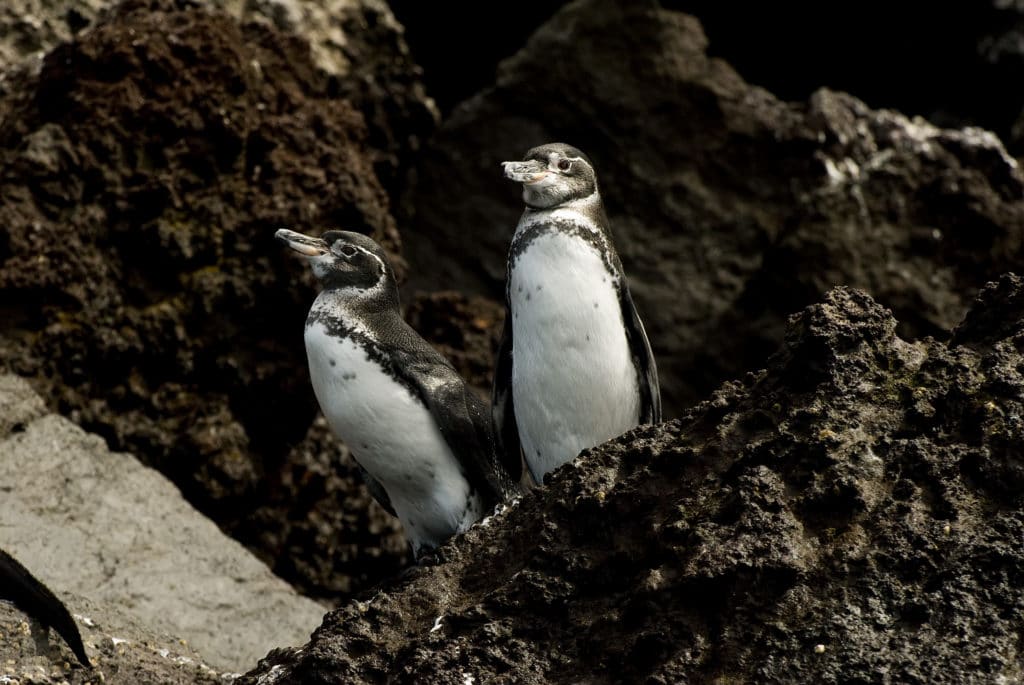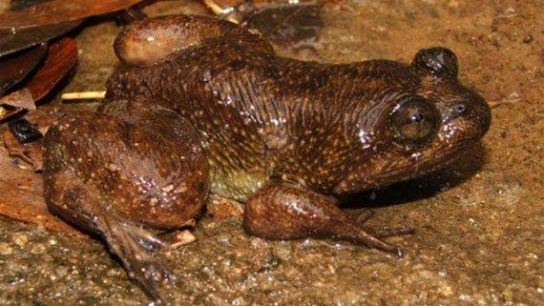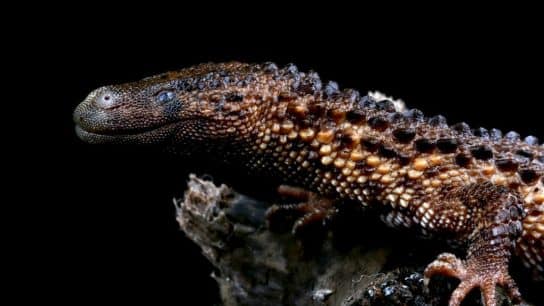The Galapagos penguin is the most northerly occurring species of penguin in the world, endemic to the Galapagos Islands of Ecuador. They are believed to have travelled to the islands from Antarctica on the Humboldt Current, an ocean current of cold, nutrient-rich water that travels up along the west coast of South America. Despite the drastic change in habitat, these penguins developed several morphological adaptations to survive within the Galapagos’ unique climate and ecosystem. Although once an isolated sanctuary for the incredibly rich and unique biodiversity found on the islands, the introduction of invasive species, unsustainable fishing practices, and increasingly unstable climate conditions have led to the demise of numerous species, including the Galapagos penguin.
—
Family: Spheniscidae
Genus: Spheniscus
Species: Spheniscus mendiculus
IUCN Status: Endangered
Population: Approximately 1,200
1. Appearance
The Galapagos penguin is one of the smallest species of penguin in the world, with an average height of 49 centimetres and an average weight of 2.5 kilograms. Their slight stature is believed to be an evolutionary adaptation to the rugged, volcanic Galapagos landscape, as it allows for easy access to small caves and crevasses in which they nest, breed, and seek shelter from the intense equatorial sun.
They are characterised by thin, C-shaped strips of white feathers from the corner of each eye to the chin, and a single strip of black feathers cutting across the white breast feathers. Baby Galapagos penguins initially have brown, downy feathers which gradually moult as they grow up. Like fellow temperate penguin species, the Magellanic and Humboldt penguins of South America, the Galapagos penguin has patches of bare skin around its eyes, at the base of its bill, and on its legs, from which the animal release heat.
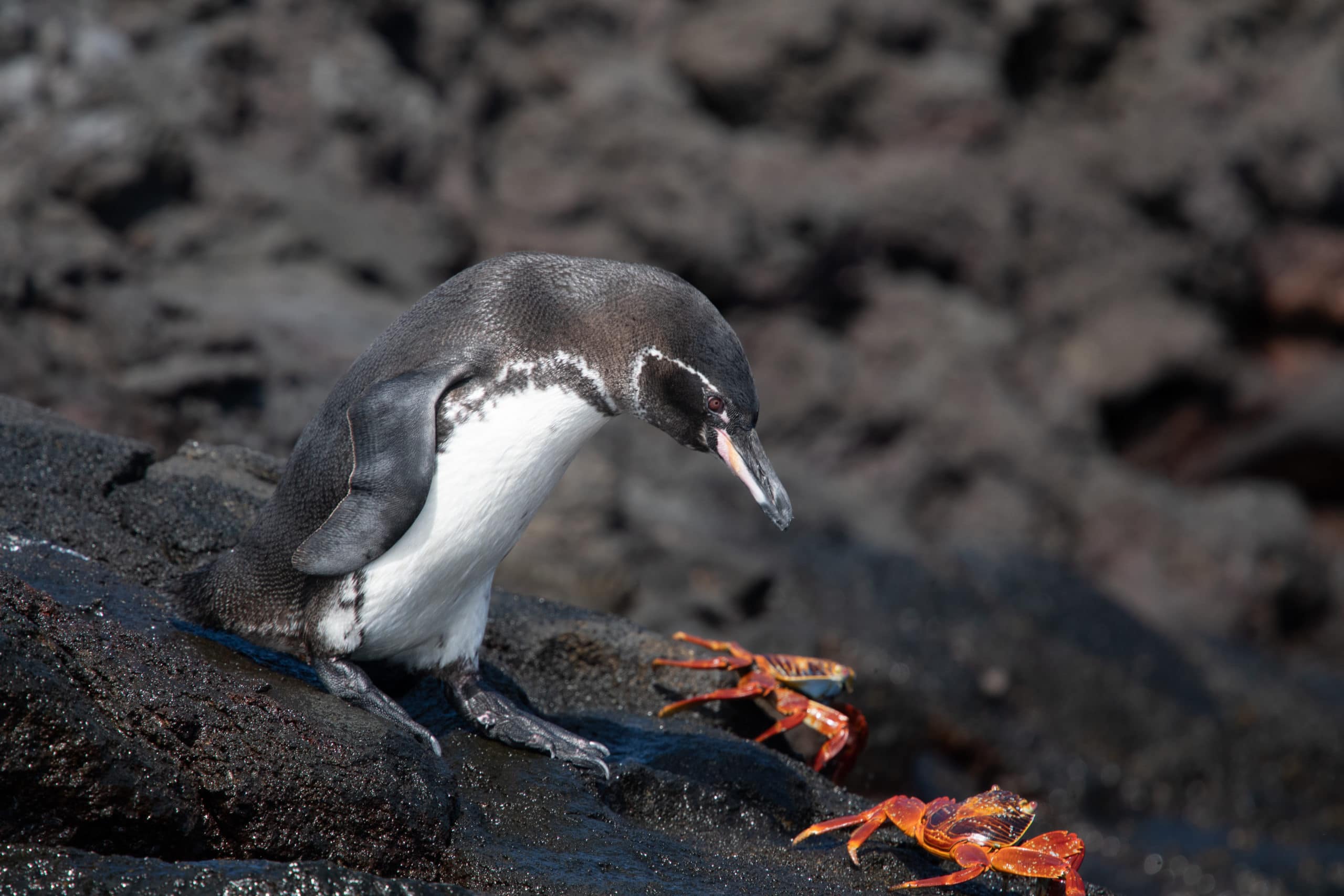
C-shaped strips of white feathers give the Galapagos penguin its distinctive appearance (photograph by Meghan Foehl for the Galapagos Conservancy).
2. Diet
As with numerous equatorial seabirds and inhabitants of the Galapagos Islands, the Galapagos penguin relies heavily upon two cold-water, nutrient-rich oceanic currents – the Humboldt and Cromwell currents – to supply a rich array of prey throughout the year. When upwelling occurs on the equator, trade winds displace warm, nutrient-poor surface water and allow for cold, productive Antarctic waters to rise. This abundance of nutrients acts as sustenance for phytoplankton, which in turn sustain an infinite number of small fish and crustacean species. As these primary producers and consumers form the basis of the ocean food chain, the Humboldt and Cromwell currents support one of the largest ecosystems in the world with incredibly high concentrations of distinctive fish and marine mammal species. Since upwelling occurs most frequently around islands and archipelagos due to shallow sea floors, the Galapagos penguin is able to hunt close to the comparatively safe shoreline.
Nevertheless, the process of upwelling is by no means a regular or frequent occurrence: trade winds are weakest during the hot, rainy season (December to May) and strongest during the cool, dry season (June to November). Upwelling thus occurs at varying strengths throughout the year, resulting in periods of unstable and unpredictable availability of prey for the Galapagos penguin.
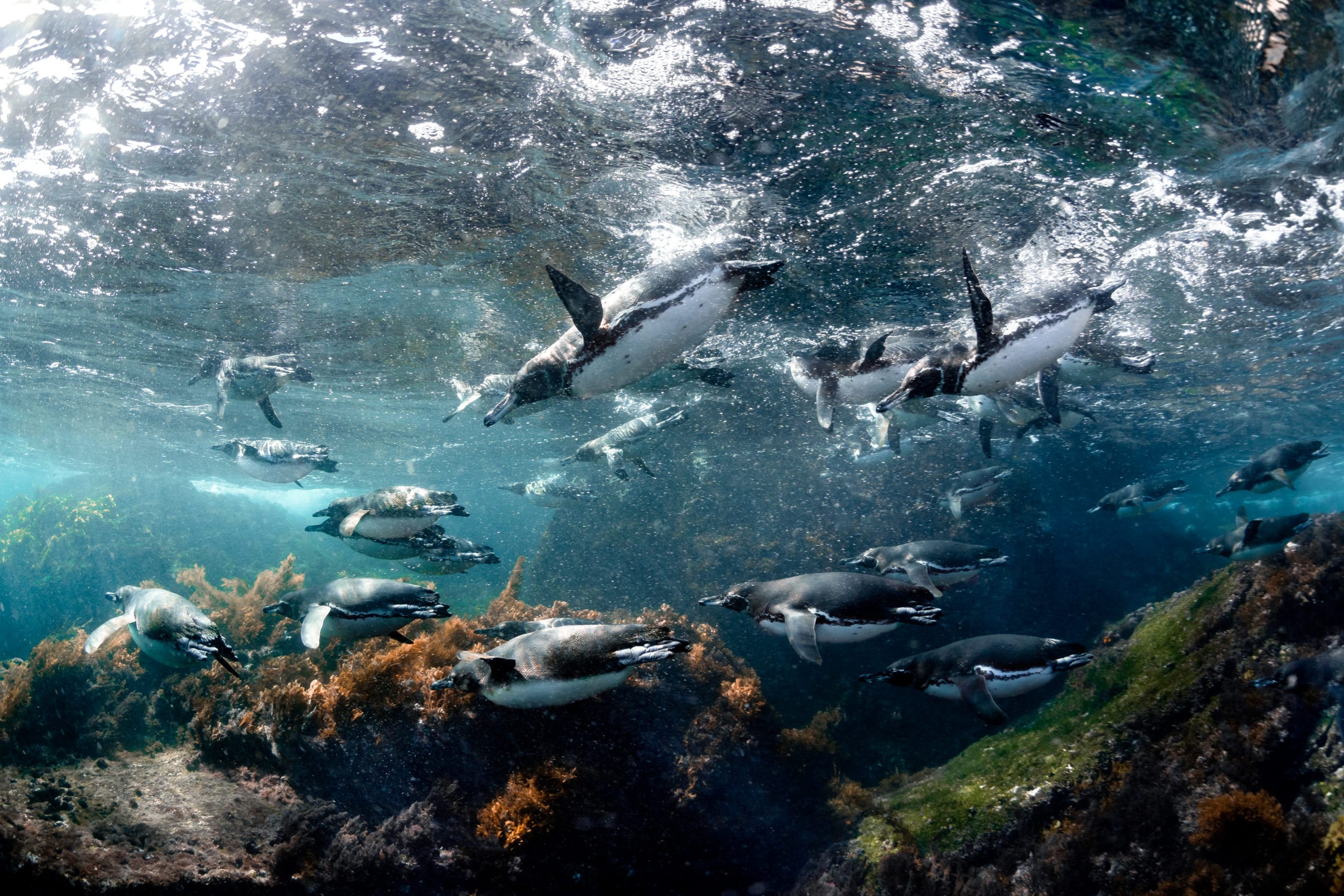
A group of Galapagos penguins swimming (photograph by Joshua Vela for the Galapagos Conservancy).
The diet of the Galapagos penguin consists mainly of cold-water schooling fish, such as sardines, anchovies, and mullet. As visual predators, they typically hunt during the day, with a clear protective membrane covering the penguin’s eyes to avoid irritation from the salt water. Despite their notoriously clumsy manner on land, Galapagos penguins are incredibly agile when underwater, swimming at speeds of 35 kilometres per hour and diving up to 27 metres deep; however, most diving trips tend to take place within five meters of the shoreline, at a modest depth of six meters and for a duration of less than one minute. Like many other pelagic-hunting penguin species, the Galapagos penguin practices group foraging, diving beneath schools of fish, herding them towards the surface, and picking them off from below. This provides fellow seabirds an opportunity to feed on the surface with relative ease.
Adult and juvenile Galapagos penguins are prey for sharks, sea lions, and Galapagos fur seals when hunting underwater. Eggs and chicks are vulnerable to the Galapagos hawk, as well as introduced predators such as rats, dogs, cats and other birds of prey.
3. Habitat and Behaviour
The Galapagos Islands are a volcanic archipelago in the Pacific Ocean, made up of 13 major islands and an undetermined number of smaller ones. Straddling the equator, a handful of islands sit in the Northern Hemisphere, whilst the majority fall in the Southern Hemisphere. Here, temperatures range from 19C to 32C. When combined with the intense equatorial sun, these temperatures make for a sweltering climate for the Galapagos penguin.
In order to survive in the unique Galapagos ecosystem, these remarkable creatures have thus developed a number of morphological and behavioural adaptations.
Whereas all other penguin species undergo one complete moult per year, the Galapagos penguin instead moults twice per year, shedding their damaged, sun-bleached, algae-stained feathers and growing new ones. However, since moulting is an energy-intensive process and the availability of prey is often unpredictable, the Galapagos penguin will prioritise moulting over breeding and complete one full moult before mating.
This contrasts with most other species of penguins in more seasonal environments, which breed before moulting. The Galapagos penguin further maintains, waterproofs, and conditions its feathers through preening – the process of rubbing oil acquired from the bird’s preen gland (at the base of its tail) across its feathers.
Due to the craggy nature of the Galapagos Island coastline, penguins are often able to find shelter from the blistering heat of the equatorial sun during the day. Yet, this is by no means the only way in which these incredible seabirds avoid overheating. Adding to the archipelago’s unique ecosystem is the fact that it is situated at the point in the Pacific Ocean where three different ocean currents converge, resulting in a remarkable mixture of cold and warm ocean waters. Therefore, Galapagos penguins not only rely on these currents for sustenance but also as a way of cooling down and escaping the intense heat. On land, these extraordinary creatures have been observed panting and standing with their flippers extended, releasing heat from under their flippers whilst protecting their bare feet from sunburn.
Due to the unpredictability of prey abundance at certain times of the year, the Galapagos penguin has evolved into an opportunistic breeder, nesting only when food is plentiful and ocean water temperatures are cool. Breeding pairs mate for life, strengthening their relationship through mutualistic behaviours such as feather preening. Although the Galapagos penguin doesn’t need to worry about their eggs freezing as Antarctic penguins do, overheating and predators are two major concerns for parent penguins nesting along the coastline. Whereas fellow South American penguin species dig burrows beneath soil or guano (a build-up of seabird excrement), the Galapagos penguin must utilise natural cracks, caves, and rock depressions within dried lava formations to nest in. If conditions are optimal, a breeding pair can produce two to three clutches of eggs per year. The majority of breeding takes place on the Islands of Isabela, Fernandina, Floreana, and Bartolomé.
Once a pair has mated, the female can lay up to two eggs, which are then incubated by either parent for a period of 35 to 42 days. Until the hatched chicks are 21 to 30 days old, one parent guards the nest whilst the other forages for food. The foraging penguin finds its way back to the nest through a distinctive honking bray call, which these animals use for individual identification.
Chicks become fully-fledged and independent after approximately 60 days, although in times of plenty parent penguins have been shown to continue feeding fledglings. Aside from the Galapagos penguin, this unique post-fledging parental care has been observed in just one other penguin species, the sub-Antarctic Gentoo.
It is hypothesised that post-fledging care in the Galapagos penguin is an evolutionary adaptation to maximise reproductive success, as offspring are given the opportunity to further practice their hunting abilities before having to catch their own food. However, if resources are scarce, parent penguins will abandon their chicks and skip breeding windows to survive times of famine. In a statement, Doctor Dee Boersma – a leading expert on Magellanic and Galapagos penguins – noted that: “Galapagos penguins have adapted themselves not to the seasons, but to the whims of the bounty of the ocean.”
4. Services
The Galapagos penguin’s method of group foraging provides feeding opportunities for a number of seabirds, such as brown pelicans, brown noddies, and flightless cormorants. By swimming beneath schools of fish, the foraging penguins prompt their prey to swim to the surface of the water, allowing any awaiting predators to partake in the meal. Yet, from a broader perspective, the Galapagos penguin plays a crucial role within the ecosystem of the islands through its place in the food chain.
Adult penguins serve as an important source of food for a multitude of predators, such as sharks, whales, sea lions, and fur seals, whilst chicks and juveniles are preyed upon by crabs, snakes, hawks, and owls. In turn, they carry out population control on schooling fish, crustaceans, and cephalopods, transport essential nutrients from the ocean to the land, and enrich both habitats with the nitrogen, phosphorus, and organic carbon found within their faeces. By researching and analysing penguins as a keystone species within the Galapagos Islands, scientists can assess the health and condition of their predators, prey, and the local ocean ecosystem.
From an emblematic standpoint, the Galapagos penguin is the one of the rarest species of penguin in the world with a mere 1,200 individuals remaining and is strictly endemic to the Galapagos Islands. A testament to Charles Darwin’s theory of evolution, the Galapagos penguin is a remarkable species with incredible morphological and behavioural adaptations to suit its unique habitat. The entirely preventable extinction of this magnificent creature would be a tremendous loss to the scientific community and to the greater natural world.
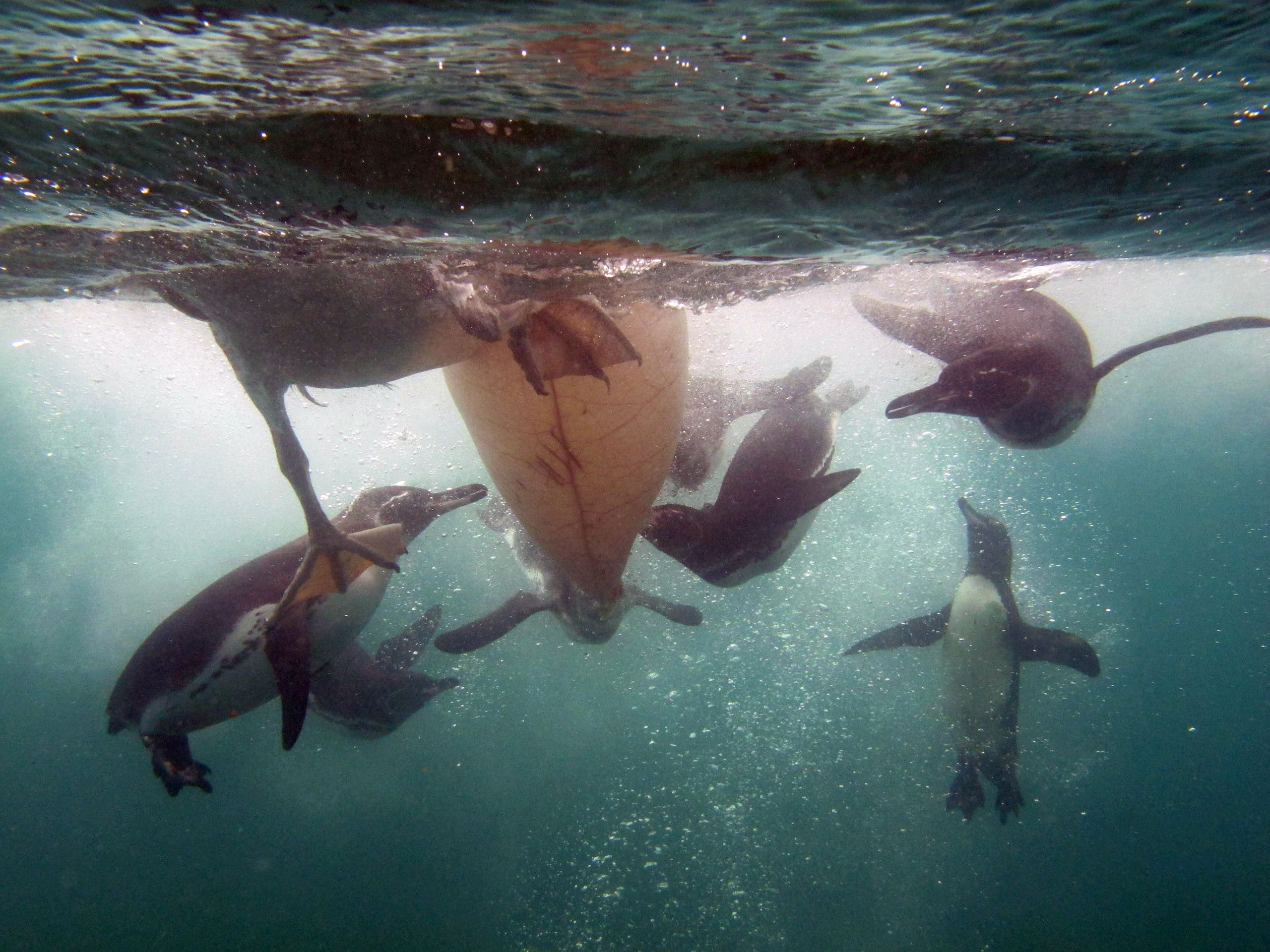
Galapagos penguins searching for food with a brown pelican (photo by Cynthia M. Manning for the Galapagos Conservancy).
5. Threats
With a relatively limited population size and geographic range from the outset, as well as a heavy reliance on unpredictable oceanic currents, the vulnerable Galapagos penguin population was quickly threatened with extinction upon the introduction of several novel influences on the Islands. Apart from direct anthropogenic factors, such as unsustainable fishing practices, pollution, and invasive species, climate change has had an immense impact on marine perturbations brought about by El Niño Southern Oscillation (ENSO) events.
Having suffered a population decline of 60% between 1970 and 2004, and with scientists predicting a further population decline of 80% in the next 100 years, in 2000, the International Union for Conservation of Nature (IUCN) listed the Galapagos penguin as ‘endangered’.
Due to the rich and unique array of biota endemic to the Galapagos Islands, the archipelago is both a national park and a UNESCO World Heritage Site. Established in 1959, the Galapagos National Park was set up to protect the extraordinary species of wildlife and plants on and around the islands, as well as to preserve the historical scientific observations made by Charles Darwin in developing his theory of evolution. Upon listing the archipelago as a UNESCO World Heritage Site, the organisation provided four reasons for its decision: the unique marine environment; the archipelago’s continuous geologic formation; the role of the islands’ flora and fauna in understanding evolution and climatic influences; and its biological diversity.
Nevertheless, in 2007 the islands were placed on UNESCO’s list of Threatened World Heritage Sites, as growing rates of tourism began placing an increasing amount of strain on the environment. Although praised for its remote location, scientists soon discovered the increased vulnerability of isolated flora and fauna to marine pollution, as it holds little tolerance for habitat disturbance and lacks a suitable alternative terrain. Although the archipelago was removed from the list in 2010, owing to the incredible efforts of the Ecuadorian government in protecting the integrity of the Galapagos ecosystem, human activity continues to plague the once pristine landscape.
In a 2021 study conducted by the University of Exeter, the Galapagos Conservation Trust, and the Galapagos Science Center, up to 449 microplastic particles were discovered per square metre of beach area on the Eastern coast of the archipelago, and approximately 4,610 pieces of macroplastics (plastic measuring over 5mm) were recovered over 13 beaches. Only two percent of this plastic pollution was determined to have originated from the islands, with the vast majority emanating from the 304,000 tonnes of mismanaged coastal plastic waste that Ecuador and Peru produce yearly.
As the Humboldt current travels north along the west coast of South America, it is believed to be the primary vehicle for plastic pollution from the mainland. Species that rely heavily upon the current for sustenance, such as the Galapagos penguin, therefore face an increased risk of ingestion and entanglement; feeding regurgitated plastic to offspring and filling the incredibly delicate food chain of the Galapagos with this indigestible material. Additionally, plastic debris has been identified as a novel substrate for rafting organisms, such as cyanobacteria, algae, protists, invertebrates, and even terrestrial vertebrates, acting as a potential channel for invasive species to reach the Galapagos Islands.
You Might Also Like: Are Microplastics Harmful and How Can We Avoid Them?
An invasive species is a living organism that is introduced into an ecosystem to which the organism is not native. Such invasive species, typically introduced by humans, can cause grave ecological disturbances as they lack natural predators, spread new diseases, and compete with endemic species for resources such as food and territory.
On the Galapagos Islands, the intentional introduction of feral cats in 1832 has since posed an enormous threat to penguin populations on numerous islands. Not only do they prey upon penguin eggs and chicks within breeding sites, but also on fledglings and adults alike; in one instance, a single cat observed within a penguin breeding area caused an adult mortality rate of 49%.
In addition to predation and habitat disturbance, feral cats are amongst the numerous invasive species that carry potent diseases previously unknown to the inhabitants of the Galapagos. In the 1980s, mosquitos were inadvertently brought to the island, where they effectively acted as vectors for avian malaria and the West Nile virus – two diseases to which the Galapagos penguin is highly susceptible. Most concerning to scientists was the discovery of the Plasmodium blood parasite in numerous penguins in 2009, with no clear indicator of its origin. Although initially uncertain about the gravity of the infection on the species, studies later indicated a potentially drastic decline in population numbers as a result of the parasite.
Another critical threat facing the Galapagos penguin is unsustainable fishing. Under the management of the Galapagos National Park is the Galapagos Marine Reserve, one of the most ecologically diverse marine protected areas (MPAs) in the world. Within the initial reserve area, which comprised approximately 133,000 square kilometres of ocean surrounding the islands, only local Galapagos residents were permitted to conduct small-scale, manual fishing expeditions; scientists from the marine reserve often implemented education campaigns aimed at local residents to promote sustainable fishing practices.
Nevertheless, foreign commercial fishing vessels lurking at the fringes of the marine reserve often sought to profit from the rich array of marine species that travelled through the area. In 2017, a Chinese ship carrying 300,000 kilograms of illegal marine wildlife was seized and detained by Ecuadorian officials, having carried out illicit fishing practices within the reserve. Despite a fine of USD 6.1 million and a prison sentence of three years for the ship’s crew, the Chinese fishing industry remained undeterred as a Chinese-flagged flotilla of 342 ships was reported by Ecuadorian officials in 2020. Apart from depleting the Galapagos penguin’s already vulnerable source of prey, the use of purse seine nets and similar unsustainable fishing practices pose a risk of entanglement to the pelagic-hunting species. Poorly managed waste produced by fisheries, including the disposal of nets and plastic fishing equipment into the ocean, contributes to approximately 30% of marine pollution within the Galapagos Marine Reserve and further increases the risk of entrapment for marine life.
You Might Also Like: WTO Bans Fishing Subsidies in Historic Deal to Reduce Global Overfishing
Although the COVID-19 pandemic has benefited wildlife in the absence of tourists, that same absence of tourists has exposed the vulnerability of the Galapagos Islands since 90% of its economy is dependent on tourism. Entrance fees to the national park aid with the conservation and maintenance of the islands, and the tourism industry provides a source of income for many locals. Without tour boats and local fishermen traveling out on the water, no one patrols the boundaries of the marine reserve for illicit fishing or collects plastic detritus floating on the surface.
Of the threats posed to the Galapagos penguin population, perhaps the most severe is climate change and the aggravating effects it has on climate patterns. The natural phenomenon known as El Niño Southern Oscillation (ENSO) is a cyclical, large-scale climatic event in which ocean surface temperatures rise and surface winds weaken or change directions in the Pacific Ocean. As a result, upwelling around the Galapagos Islands decreases, leading to fewer nutrients in the pelagic zone, lower plankton concentrations, and a sharp decline in fish populations. In such times of famine, Galapagos penguins skip breeding to avoid starvation, as the decreased resilience of adults towards predation and disease places individuals at greater risk of death. Strong El Niño events in 1982-83 and 1997-98 caused population declines of 77% and 65%, respectively, with recovery rates hindered by the disproportionate effect of such events on female mortality rates. Although a natural phenomenon, evidence has begun to indicate a possible rise in the frequency of ENSO events as a result of climate change.
6. Conservation
The government of Ecuador, together with local populations, national charities, international organisations, scientific communities, and fellow world leaders, have worked incredibly hard over the past decades to preserve the unique and delicate ecosystem of the Galapagos Islands. 95% of the Galapagos penguin population is typically found on just two islands, Isabela and Fernandina, which are both under the protection of the national park. As such, authorities have been able to work towards mitigating the effects of invasive species, human disturbance, pollution, and illicit fishing.
One of the problems identified by Doctor Dee Boersma when conducting research on the Galapagos Islands was the lack of suitable nest sites for penguins to breed in. Previously used sites are typically flooded, overtaken by marine iguanas, or no longer exist after a period of time.
As breeding success depends predominantly on the availability of prey, conservationists have highlighted the importance of high-quality nest sites so that when conditions are favourable and prey is abundant, penguins are able to keep their eggs safe. In 2010, with the support of the Galapagos Conservancy, Doctor Boersma and her research team built 120 shaded nests from stacked lava rocks and tunnels dug into slopes within primary nesting areas. Subsequent biannual monitoring trips have allowed the team to assess the efficacy of the constructed nests in bolstering reproductive success when food is plentiful. Since the program’s inception, almost 25% of all observed breeding activity has taken place within constructed nests. On some islands, such as in the Mariela Islands, constructed nests were utilised by 43% of breeding penguins in some years. After the El Niño events of 2016, Doctor Boersma’s team counted just one juvenile penguin amongst over 300 adults, with adults in algae-ridden feathers showing signs of malnutrition. Yet by 2017-2018, juvenile penguins accounted for 60% of all penguins observed, all of which were in healthy condition.
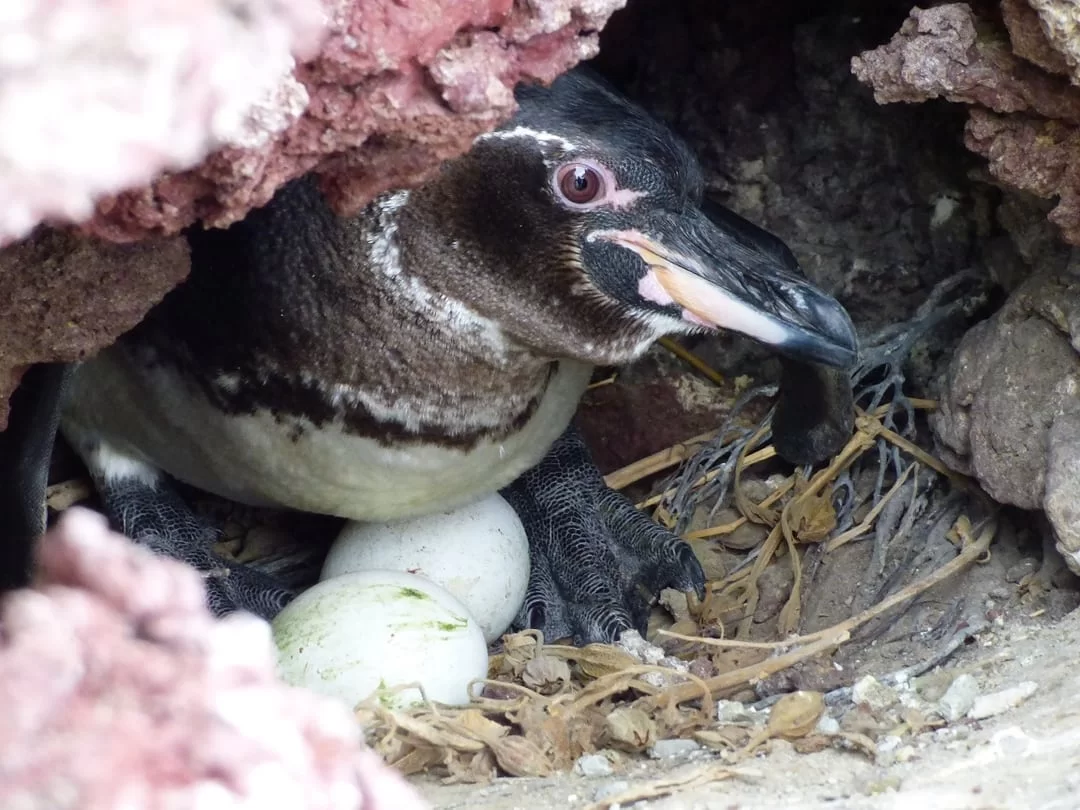
Parent Galapagos Penguin keeping their eggs safe (photography by Doctor Dee Boersma).
Another crucial factor in optimising breeding success and promoting population growth is the eradication of invasive species from key breeding sites. Extensive measures have been implemented by national park authorities, such as checking the bags of visitors upon entering and leaving the islands, to ensure that non-native flora and fauna are not accidentally or purposefully brought to the islands. Authorities also search actively for invasive plants or wildlife and eliminate those located, which has resulted in the complete eradication of invasive species from certain islands.
Bolstering conservation aims and agendas is the tremendous amount of research that is conducted by scientific teams, establishing the species’ needs through building a better understanding of its ecological background. By collecting, marking, weighing, and measuring penguins on the islands, researchers are able to determine the general health, moulting frequency, diet, nesting habits, and population trends of the species, which consequently guide decisions on conservation initiatives such as the establishment of protected areas and restricted breeding sites.
Organisations such as the Galapagos Conservancy and the Charles Darwin Foundation have been at the forefront of such research, aiming to expose the vulnerability of Galapagos penguins to anthropogenic threats and climate change. iGalapagos.org, established by Doctor Boersma and the Centre for Ecosystem Sentinels, is a program whereby those visiting the Galapagos Islands can submit photographs of any penguins they observe, along with the location of the sighting and any additional notes. This allows researchers to monitor the breeding activity, population size, migratory habits, and moulting frequency of the penguins remotely.
In January 2022, the government of Ecuador announced the creation of a new Marine Protected Area (MPA) north of the Galapagos Islands, named the Hermandad Reserve, to protect migratory species. Adding approximately 60,000 square kilometres to the current marine protected area, the new reserve was described as the first step in a plan between Ecuador, Colombia, Costa Rica, and Panama to establish a protected migration corridor for endangered species between the Galapagos Islands and the Coco Island National Park. Although non-migratory by nature, Galapagos penguins stand to benefit from this expansion with the prohibition of commercial fishing activities in the designated area. Doctor Boersma and her research team have further suggested the creation of a Marine Protected Area in Elizabeth Bay, due to the high density of penguin breeding that occurs on the Mariela Islands, as well as an MPA around Bartolomé Island.
Nevertheless, for maximum efficacy, MPA initiatives must be accompanied by stricter enforcement of fishing bans within the reserve. New technologies have been introduced to rangers and local fishermen alike in the hopes of locating and apprehending illegal fishing vessels, within the MPA as well as in Ecuador’s Exclusive Economic Zone. Organisations such as the Galapagos Conservation Trust (GCT) have been working with local communities on improving fishing practices, introducing effective waste management, establishing catch quotas, and involving fishermen in conservation initiatives. Eco-friendly fishing techniques – such as green stick or kite fishing – and new fishing gears are regularly introduced and distributed amongst locals as well.
NGO Spotlight
Apart from funding the incredible work carried out by Doctor Boersma and her research team in creating 120 shaded nesting sites for the Galapagos penguin population and monitoring their progress, the Galapagos Conservancy has implemented a number of initiatives aimed at safeguarding the future of the Galapagos ecosystem. The Education for Sustainability Program provides formal education to the local youth population of the Galapagos Islands, focusing on three pillars of sustainability (economy, society, and nature), in addition to essential themes, such as invasive species, food security, transportation, energy, water, and social inclusion. The program educates local communities by utilising the incredible landscape of the Galapagos as a classroom, supporting critical thinking, and encouraging contributions to the wellbeing of the environment.
The Women in Sustainable Entrepreneurship (WISE) Program similarly encourages conservation within local communities, providing funds and education to female entrepreneurs who are hoping to form the foundation of a more equitable and sustainable economy for the Galapagos. One such remarkable entrepreneurship project funded by the program is Karina Bautista’s Huerta Luna Farm, a research farm focused on discovering the agroecological techniques best suited for farming in Galapagos.
How to Help
- Donate funds or time to a charity. Organisations such as the Galapagos Conservancy fund a myriad of projects for the protection and conservation of the Galapagos ecosystem. By donating money or volunteering your time with the organisation, you can help support these incredible organisations and the honourable work they do in safeguarding the future of the Galapagos.
- Be responsible with plastic. When shopping at the supermarket, make conscious decisions about the amount of single-use plastic that you purchase. Opt for unwrapped fruits and vegetables, avoid individually-wrapped snacks, and make sure to bring along a reusable shopping bag. If you do happen to purchase any plastic products, be sure to recycle them or dispose of them responsibly.
- Upon visiting the Galapagos Islands, be sure to abide by the following rules: stay on the designated trails at all times; do not collect any shells, stones, pieces of coral, or any form of flora and fauna; do not litter and do not bring food or any live organisms to the islands.
- Reduce your carbon footprint. Aside from direct anthropogenic factors, climate change is one of the biggest threats to the wildlife of the Galapagos Islands. Make conscious decisions about the transport you take, limit your meat and fish consumption, eat locally and seasonally, and opt for energy-efficient appliances at home.
Featured Image by Laura L. Fellows for the Galapagos Conservancy
If you want to learn more about endangered species, make sure to check out other articles from our Endangered Species Spotlight Series










